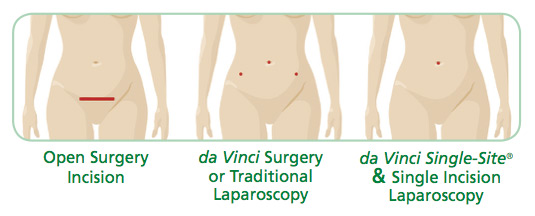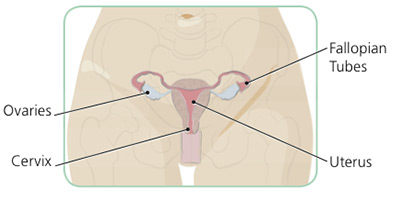With da Vinci Single-Site Surgery, doctors remove your uterus and possibly your ovaries and fallopian tubes through your belly button. Patients who choose da Vinci Single-Site Surgery experience virtually scarless results, similar to single incision traditional laparoscopy.
Early clinical data suggests da Vinci Single-Site Hysterectomy offers the following potential benefits:
The da Vinci Surgical System is designed to provide surgeons with enhanced capabilities, including high-definition 3D vision and a magnified view. Your doctor controls the da Vinci System, which translates his or her hand movements into smaller, more precise movements of tiny instruments inside your body. da Vinci Single-Site Patient Incision
Though it is often called a “robot,” da Vinci cannot act on its own. Surgery is performed entirely by your doctor. Together, the da Vinci System and Single-Site® instruments allow your doctor to remove your uterus, fallopian tubes and/or ovaries through a single incision, similar to single incision traditional laparoscopy. As a result, you may be able to get back to life without the usual recovery that follows major surgery.
Single-Site*/Single Incision: Your uterus can be removed through a small incision in your belly button using single-incision traditional laparoscopy or da Vinci® Single-Site® Surgery. These procedures allow for virtually scarless results.**
Laparoscopy: Laparoscopic surgery is also minimally invasive. With traditional laparoscopy, your surgeon operates through a few small incisions using long instruments and a tiny camera to guide doctors during surgery. Another laparoscopic option is robotically-assisted da Vinci Surgery. Your uterus is also removed through a few small incisions (ports) in your abdomen. da Vinci technology provides your surgeon with enhanced vision, precision and control.*
Abdominal Hysterectomy: During an abdominal hysterectomy (open surgery), your uterus is removed through a large open incision. The incision must be large enough for your surgeon’s hands to fit inside your body and reach your organs.
Vaginal Hysterectomy: A vaginal hysterectomy is done through a cut in your vagina. The surgeon operates through this incision and closes it with stitches.

*Single-Site is available for benign conditions
**With minimally invasive surgery, there are various options for removing the uterus. Your surgeon will recommend the option he/she thinks is best for you.
Chronic Pain, Heavy Bleeding, Fibroids, Endometriosis, Adenomyosis, Pelvic Prolapse
Many benign (non-cancerous) conditions can affect a woman’s reproductive system, including the uterus, cervix, ovaries and fallopian tubes.
Common benign conditions include: fibroids, which are growths in and/or around the uterus; endometriosis, which occurs when your uterine lining grows outside the uterus; adenomyosis, which occurs when your uterine lining grows into the wall of the uterus; and pelvic prolapse, which is the slipping of the uterus, vagina and/or bladder.
Gynecologic conditions can cause many different symptoms or no symptoms at all. Some of the
more common symptoms may include: pelvic pain, heavy bleeding, irregular periods, fatigue, unusual bloating, pain during intercourse, and infertility.
If your symptoms are severe, your doctor may suggest medicine, lifestyle changes or surgery. Surgical options will depend on your exact condition, symptoms and overall health.

Your doctor may recommend a hysterectomy (removal of your uterus and possibly ovaries and fallopian tubes). A hysterectomy is the second most common surgery among women in the United States.1 There are different ways to perform a hysterectomy, as detailed below. You should discuss all options with your doctor if he/she recommends a hysterectomy.